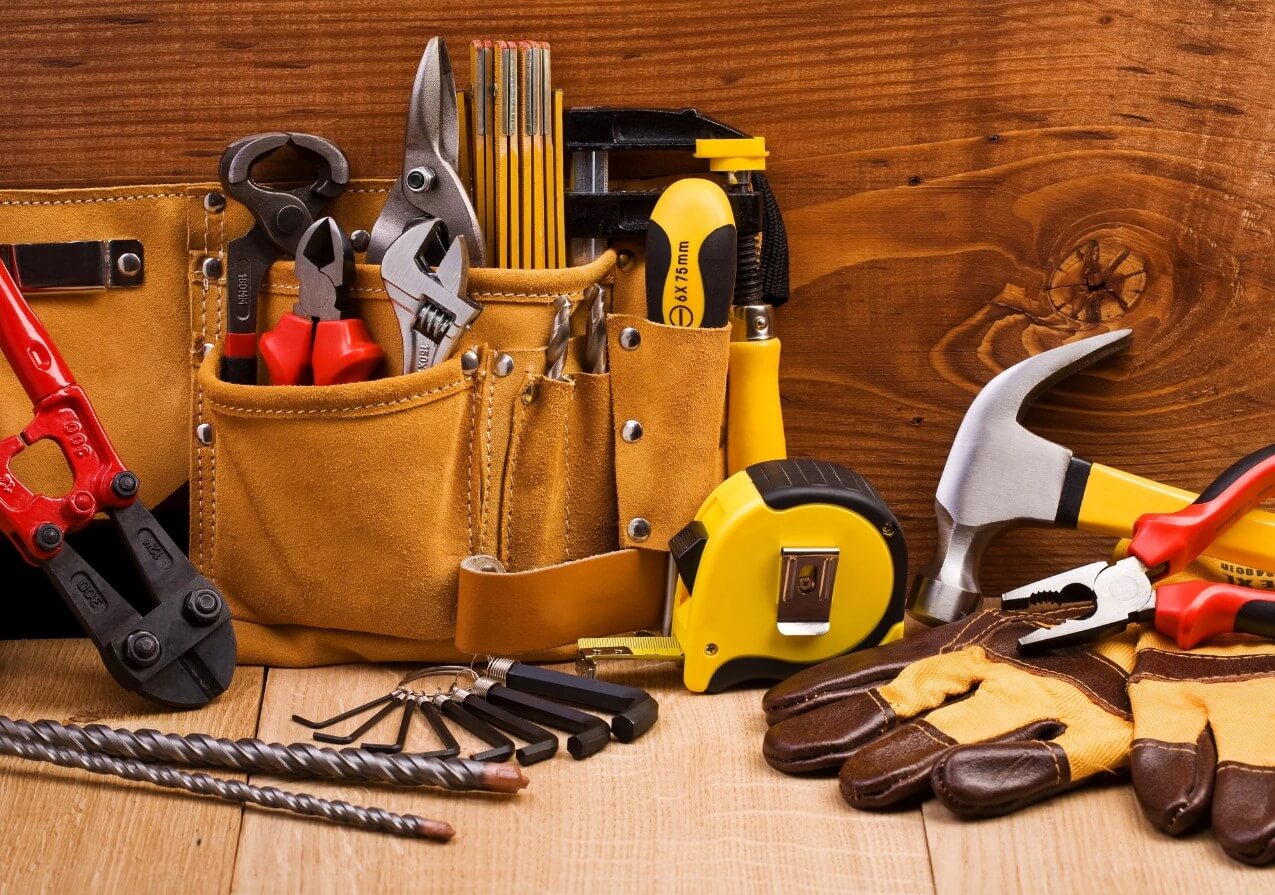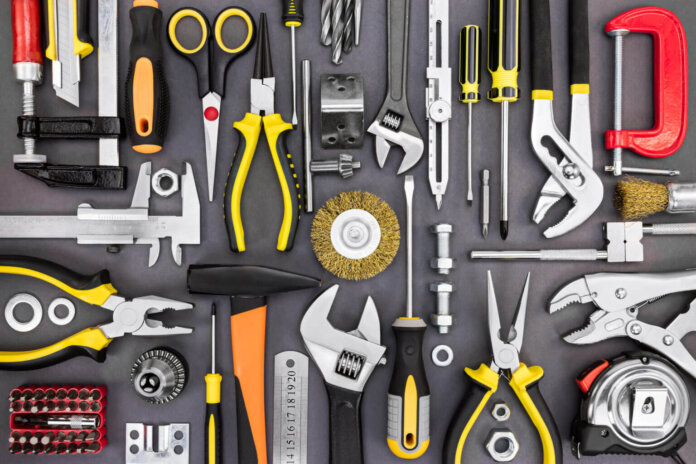Automotive laboratory materials refer to the various tools, instruments, and equipment used in the testing and analysis of automotive components, systems, and materials. These materials are essential for ensuring the safety, efficiency, and quality of vehicles and their components.
Here are the top 65 Automotive Laboratory Materials Explanation.

- Compressor: Used for providing compressed air to pneumatic tools, inflating tires and sporting equipment, and powering airbrushes and spray guns.
- Screwdriver (star & minus): Used for tightening or loosening screws with a star or flathead slot respectively.
- Double End Ring Spanner: Used for tightening or loosening nuts and bolts with two different sizes of openings.
- Open and close (fix) spanner: Used for tightening or loosening nuts and bolts with a fixed size opening.
- Socket spanner: Used for tightening or loosening nuts and bolts with a socket opening, often used with a ratchet handle.
- Pliers: Used for gripping, cutting, and bending materials such as wires and cables.
- Monkey pliers: A type of pliers with an adjustable jaw that can be used for gripping and turning objects of varying sizes.
- Outer and inner pliers: Used for gripping and manipulating objects with an outer or inner surface respectively.
- Toolbox: Used for storing and organizing hand tools.
- T spanner (Tommy) set: Used for tightening or loosening nuts and bolts with a T-shaped handle.
- Allen key set: Used for tightening or loosening screws with a hexagonal socket.
- Tappet puller: Used for removing tappets from an engine.
- Tappet gauge: Used for measuring the clearance between a tappet and a camshaft.
- Oil can: Used for lubricating machinery and tools with oil.
- Jack hydraulic: Used for lifting heavy objects such as cars and trucks.
- Bench vice: Used for holding materials in place while they are being worked on.
- Pneumatic tool: Powered by compressed air, these tools are used for tasks such as drilling, grinding, and sanding.
- Equipment stands: Used for holding equipment in place during use.
- Oil pressure gauges: Used for measuring the oil pressure in an engine.
- Tire pressure gauges: Used for measuring the air pressure in tires.
- Alignment wrenches: Used for adjusting the alignment of wheels.
- Chain wrenches: Used for gripping and turning pipes and other cylindrical objects.
- Locking wrenches: Used for tightening or loosening nuts and bolts with a locking mechanism.
- Lug wrenches: Used for tightening or loosening lug nuts on vehicle wheels.
- Carbon scrapers: Used for cleaning carbon build-up from engine components.
- Gasket scrapers: Used for removing old gasket material from engine components.
- Scrapers: Used for removing paint and other materials from surfaces.
- Spoons: Used for shaping and smoothing materials.
- Vernier calipers: Used for measuring small distances with high accuracy.
- Micrometer: Used for measuring small distances with even higher accuracy than vernier calipers.
- Feeler gauges: Used for measuring small gaps and clearances.
- Temp gauge: Used for measuring measure the thermal state of a homogeneous substance.
- Multimeter: Used for measuring electrical parameters such as voltage, current, and resistance.
- Flow meter: Used for measuring the flow rate of fluids.
- Dial gauge: Used for measuring linear displacement with high accuracy.
- Hand tools: Tools that are powered by hand, such as wrenches and screwdrivers.
- Power tools: Tools that are powered by electricity or other means, such as drills and saws.
- Lifting and jacking equipment: Used for lifting heavy objects such as cars and trucks.
- Tensioning equipment: Used for applying tension to bolts and other fasteners.
- Brake roller tester: Used for testing the braking performance of vehicles.
- Chassis dynamometer: A chassis dynamometer is a tool that measures the performance of a vehicle by simulating various road conditions. It is commonly used to test engine output, emissions, and fuel efficiency.
- Suspension activation: Suspension activation tools are used to test and adjust the suspension system of a vehicle. They allow technicians to simulate various driving conditions and adjust the suspension settings to optimize vehicle handling and performance.
- Security activator: A security activator is a device used to activate security features on various electronic devices and automobiles such as Two wheelers, Four wheelers, laptops, smartphones, and tablets. This could include facial recognition, fingerprint scanning, security alarm, or password input.
- Gloves: Gloves are used to protect hands from various hazards in different settings such as medical, laboratory, automotive, and construction industries.
- Safety shoes: Safety shoes are footwear designed to protect the feet from various hazards, including falling objects, sharp edges, and chemical spills. They are commonly used in industrial settings.
- Goggles: Goggles are protective eyewear designed to protect the eyes from various hazards such as chemical splashes, debris, and UV radiation. They are commonly used in industrial, medical, and scientific settings.
- Boiler suit: A boiler suit is a one-piece garment worn to protect the body and clothing from various hazards in industrial settings such as welding, construction, and chemical handling.
- Fire extinguishers: Fire extinguishers are portable devices used to put out fires in emergency situations. They contain various extinguishing agents such as water, foam, dry powder, and carbon dioxide.
- First Aid: First aid is the initial care provided to an injured or sick person until medical professionals arrive. It includes basic medical procedures such as wound cleaning and bandaging, CPR, and administering medication.
- Cotton waste: Cotton waste is a material used to clean various surfaces in industrial settings. It is made from leftover cotton fibers and is commonly used to absorb liquids and debris.
- Storage containers: Storage containers are used to store various materials in a safe and organized manner. They come in various sizes and materials, including plastic, metal, and glass.
- Air filters: Air filters are used to remove dust, debris, and other particles from the air. They are commonly used in HVAC systems, cars, and other machinery.
- Oil filters: Oil filters are used to remove impurities from engine oil. They prevent contaminants from damaging the engine and improve the longevity of the oil.
- Sparkplug: A sparkplug is an essential component of the ignition system in internal combustion engines. It ignites the fuel in the engine’s cylinders, enabling the engine to run.
- Glow plugs: Glow plugs are used in diesel engines to heat the combustion chamber to facilitate ignition. They are commonly used in cold weather conditions.
- Radiator: A radiator is a device used to remove heat from an engine by transferring it to the surrounding air. It is an essential component of the cooling system in vehicles.
- Pressure cap: A pressure cap is a component of the cooling system in a vehicle. It regulates the pressure in the cooling system, preventing overheating and coolant loss.
- Thermostat: A thermostat is a component of the cooling system in a vehicle. It regulates the engine’s temperature by controlling the flow of coolant through the radiator.
- Disc brake: A disc brake is a type of brake system used in vehicles. It uses a caliper to squeeze brake pads against a disc, creating friction and slowing down or stopping the vehicle.
- Motorcycle: A motorcycle is a two-wheeled motorized vehicle used for transportation, recreation, and sport.
- Laptop: A laptop is a portable computer designed for personal and professional use. It allows users to access the internet, create documents, and perform various tasks on the go.
- Multifunction printer with scanner: This is a device that combines printing, scanning, copying, and sometimes faxing capabilities into one machine.
- Reference book: A reference book is a book that is designed to provide information on a particular subject or field.
- Brochure: A brochure is a printed piece of marketing or informational material that is usually folded into a small booklet.
- Signboard: A signboard is a flat panel or board that displays information or advertising
